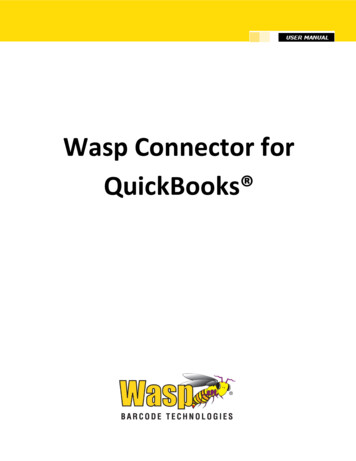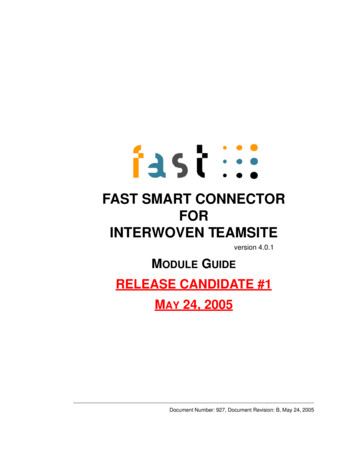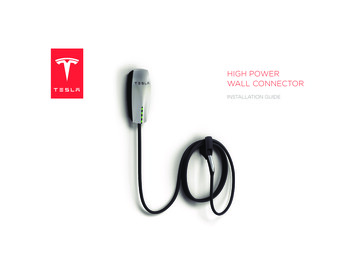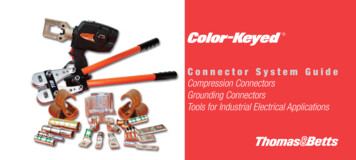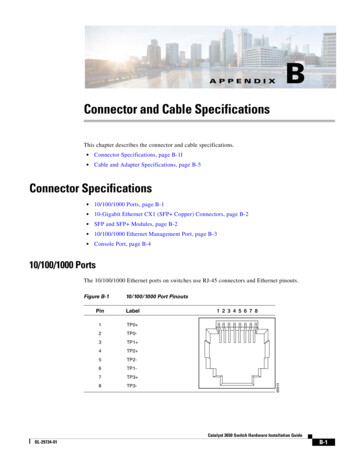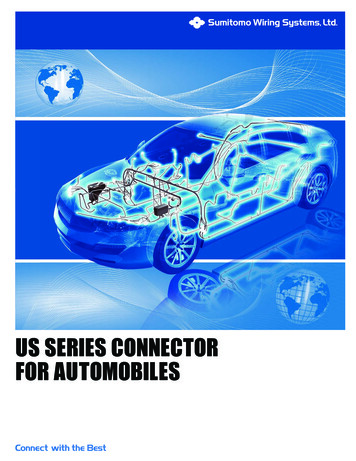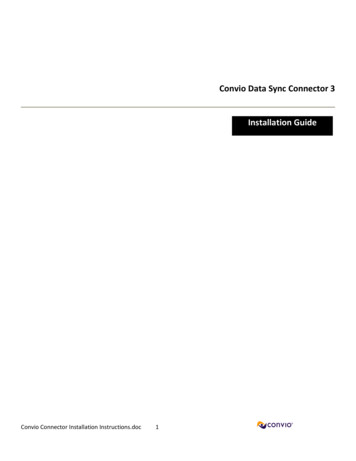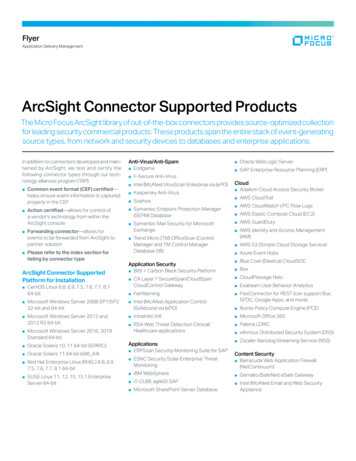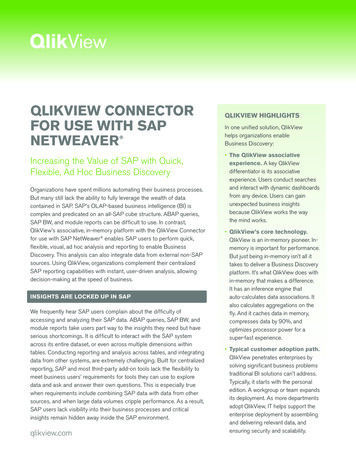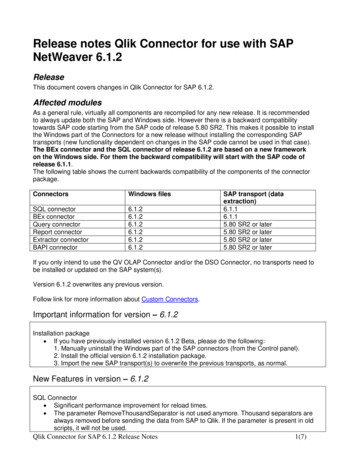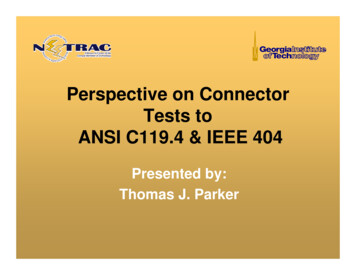
Transcription
Perspective on ConnectorTests toANSI C119.4 & IEEE 404Presented by:Thomas J. Parker
Introduction Results previously reported at ICC have indicated there may be aproblem with connectors installed on filled strand conductors. The NEETRAC membership is sponsoring work to investigate theeffect(s) that filled strand conductor has on connector performance. Test methods applied:– IEEE 404 in-air heat rise and cyclic aging of medium voltage jointsat different temperatures– ANSI C119.4 current cycle submersion tests of connectors Test samples included:– Conductor with non-filled and different types of filled strandmaterials– Different connectors and joints– Wire-brushed and not wire-brushed connections
Project AdvisorsCompany3MAmerenAmerican Electric PowerBaltimore Gas & ElectricBorealis Compounds LLCCooper Power SystemsDominion-Virginia PowerDow Chemical CompanyDuke-EnergyExelonNSTAR Electric and GasOncor Electric DeliveryPrysmian Cables and SystemsSouth Carolina Electric & GasSouthern CompanySouthwireThomas & BettsTyco / RaychemIndividualsBill TaylorHarry HayesDoug Fitchett, Carol Liu, Austin McMillionJohn SpenceDominic KungAndy LemmingerSteve BolesYimsan GauJon Carter, Chris FletcherJim Crane, John Hans, Dan ZoladzVanessa Dube, Ruvani NagageRichie HarpChris AmickMark FurtickTim WallKim Knuckles, Joe McAuliffe, Nick WareMatt Cawood, Jim ZahnenAlexander Bulza, Miguel Contreras
ANSI C119.4 Test Samples Conductor : 1/0 AWG Class B Compressed 1350 Al 3/4HD– Without Filled Strand Material, Non-filled– Filled Strand Material, Fill-1– Filled Strand Material, Fill-2 Connectors : Two different 1/0 AWG Compression SleeveConnectors (crimped using recommended die withthree crimps per side according to manufacturerinstructions)– Small : 2.15 inches long and 0.65 inch diameter– Large : 3 inches long and 0.90 inch diameter
ANSI C119.4 CCST(Current Cycle Submersion Test) 18 Samples in Test Loop A– Three replicates per condition – conductor wire brushed12 Samples in Test Loop B– Two replicates per condition – conductor not wirebrushedSamples all properly installed100 cycles – 1 hour current ON, ½ hour current OFF
ANSI C119.4 CCST ResultsConnector Temp Relative to Control Conductor Temp at 120 CANSI C119.4 at 100 Cycles (Bare)Relative Connector Temp ( torFill-2
ANSI C119.4 CCST ResultsConnector Temp Relative to Control Conductor Temp at 120 CRelative Connector Temp ( C)ANSI C119.4 at 100 Cycles (Bare)00-10-20-30-40Conductor BrushedConnectorNoYesLargeNoYesSmall
ANSI C119.4 CCST ResultsAnalysis of Variance (ANOVA)Relative Connector TemperatureFactorLevelsValuesConnectorBrushed ConductorStand Filled Conductor223Small, LargeNo, YesNon-filled, Fill-1, Fill-2SourcePConnector0.000Brushed Conductor0.000Strand Filled Conductor0.072Significance 99.9% 99.9%92.8%
ANSI C119.4 CCST ResultsMain Effects Plot for Relative Connector Temp - BARETemperature Means at 120 C Conductor TempConductor BrushedConnector Size-15Mean Temperature ( C)-20-25-30NoYesConductor Connector2.Brushed Conductor3.Filled Strand Conductor
IEEE 404 Test Samples Cable : 25 kV, 260 mil TRXLPE, 16 - #14 AWGConcentric Neutrals, Encapsulating LLDPE Jacket– Without Filled Strand Material, Non-filled– Filled Strand Material, Fill-1– Filled Strand Material, Fill-2 Joints : Two different 1/0 AWG, 25 kV rated joints (jointkits came with the same connectors previouslydescribed)– Joint A : Cold-shrink, small connector– Joint B : Molded, large connector
IEEE 404 In-Air Cyclic Aging 18 samples in one loop– Conductor WAS wire brushed before connectorinstallation on two replicates per condition– Conductor WAS NOT wire brushed before connectorinstallation on one replicate per condition 37 cycles have been completed – 8 hours current on /16 hours current off
IEEE 404 In-Air Cyclic Aging
IEEE 404 In-Air Cyclic AgingLoad Cycle HistoryTargetConductorCyclesCommentsTemperature( C )1-24-25-3031-3790IEEE Std. 404 load cycles (in air) with voltage applied-Thermocouples installed on joint connector throughhole drilled in joint housing. No test voltage applied forremainder of testing.90Seven samples found to be exceeding the controlconductor temperature at cycle 25. One was removedafter 29 cycles because it was exceeding 130 C.105Ten samples now found to be exceeding the controlconductor temperature at cycle 31 after increasingcontrol conductor temperature to 105 C.
IEEE 404 In-Air Cyclic Aging ResultsConnector Temp Relative to Control Conductor Temp of 90 CIEEE 404 at 30 Cycles (Insulated)Relative Connector illed
IEEE 404 In-Air Cyclic Aging ResultsConnector Temp Relative to Control Conductor Temp of 90 CIEEE 404 at 30 Cycles (Insulated)Relative Connector Temp30201000-10JointConductor StrandfillABFill-1ABFill-2ABNon-filled
IEEE 404 In-Air Cyclic Aging ResultsConnector Temp Relative to Conductor Temp of 105 CIEEE 404 at 31 Cycles (Insulated)Relative Connector illed
IEEE 404 In-Air Cyclic Aging ResultsAnalysis of Variance (ANOVA)for 90 C Control Conductor TemperatureFactorLevelsValuesJoint / ConnectorBrushed ConductorFilled Strand Conductor223A, BNo, YesNon-filled, Fill-1, Fill-2SourcePJoint / Connector0.110Brushed Conductor0.834Filled Strand Conductor0.061Significance89%16.6%93.9%
IEEE 404 In-Air Cyclic Aging ResultsMain Effects Plot for Relative Connector Temp of JointTemperature Means at 90 C Conductor TempJointConductor Strandfill5.0Mean Temperature ( C)2.50.0-2.5-5.0ABFill-1Fill-2Non-filledWire Brushed5.01.Filled Strand Conductor0.02.Joint / Connector-2.53.Brushed Conductor2.5-5.0NoYes
Main Effects for ConnectorTemperatureSignificance ofEffectIEEE 404 In-AirANSI C119.4 CCSCyclic Aging ofBare Conductor andMedium VoltageConnectorsInsulated Cable andJoints1(Most)ConnectorFilled StandConductor2Brushed ConductorJoint / Connector3 (Least)Filled StrandConductorBrushed Conductor
Temperature Results ANSI C119.4 CCST1 out of 30 exceeded conductortemperature (3.3%)* IEEE 404 at 90 C7 out of 18 exceeded conductortemperature (38.9%) IEEE 404 at 105 C10 out of 18 exceededconductor temperature (55.6%)NOTE: * Two failures based on resistance criteria.
What did we learn? Filled Strand always affects connector temperatures tosome extent, but the impact is different depending on thecircumstances. The impact of filled strand is– Third in significance for the ANSI C119.4 CCS test(bare connectors), but– Most significant for IEEE 404 Cyclic Aging style tests(insulated connectors). Filled Strand appears to hurt performance with bareconnectors, but may sometimes help performance withinsulated connectors.
What did we learn? Connectors run hotter in insulated tests than in bare testsfor the combinations tested Other factors affect connector performance, such as:– The choice of connector used– Wire brushing the conductor before installingconnectors Tests on bare connectors and conductor may notnecessarily be sufficient to qualify connectors for use inmedium voltage (insulated) systems.
What do we not know? We do not know about other:– Connectors or joints– Filled Strand compounds– Long Term vs. Short Term Performance We have not looked at the effect of:– Different connectors with the same joint– Incorrect installation of connectors
Additional Food for Thought Tests in existing Standards may not be sufficient to makean informed choice of the best connector for a givenapplication (existing requirements are pass / fail only)
ANSI C119 Pass / Fail vs. MarginConnector Temp Relative to Control Conductor TempFailPass0-5-10-15-20-25Increasing MarginRelative Connector Temp ( C)0-30-35Connector-AConnector-BConnector
Questions ?
Connectors : Two different 1/0 AWG Compression Sleeve Connectors (crimped using recommended die with three crimps per side according to manufacturer instructions) –Small : 2.15 inches long and 0.65 inch diameter –Large : 3 inches long and 0.90 inch diameter ANSI C119.4 Test Samples
